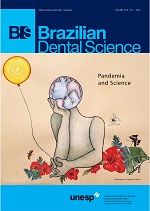Effect of storage time and composite thickness on Degree of Conversion of Bulk-fill and universal composites using FTIR method
DOI:
https://doi.org/10.14295/bds.2020.v23i2.1915Abstract
Objective: Degree of Conversion (DC) of Resin-Based composites (RBCs) is a concern and is affected by different factors. This study was conducted to evaluate the effect of different thicknesses and storage times on DC of bulk-fill and universal RBCs using the FTIR method. Material and methods: For each of dental composite (Tetric N- Ceram Bulk Fill and Tetric N Ceram), 28 samples were prepared (14 samples with 2 mm height and 14 samples with 4 mm height). One and seven days (1d and 7d) after storage in an incubator at 37 ?C, DC was measured and recorded using a FTIR device. Data were analyzed using t-test and Three-Way ANOVA and Tukey Post-Hoc Test. P < 0.05 was considered statistically significant. Results: DC of Bulk-fill composite is greater than universal composite. DC at 2 mm thickness is more than 4 mm. Unlike universal composite, 7d DC of Bulk-fill composite is greater than 1d. Of course, none of these differences are statistically significant (P-value > 0.05). Conclusions: Considering the limitation of this study, since no difference was found between DC of 1d and 7d, 1d DC is sufficient for clinical procedures, such as polishing, and the laboratory tests.
KEYWORDS
Bulk-fill composites; Degree of Conversion; FTIR.
Downloads
Downloads
Additional Files
Published
How to Cite
Issue
Section
License
Brazilian Dental Science uses the Creative Commons (CC-BY 4.0) license, thus preserving the integrity of articles in an open access environment. The journal allows the author to retain publishing rights without restrictions.
=================




























